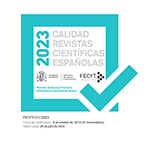La percepción multisensorial del espacio de la ciudad
Resumen
El artículo presenta una investigación realizada con estudiantes de Educación primaria de la Facultad de Pedagogía de la Universidad de Ljubljana. Nuestro objetivo era detectar si la percepción e imagen del espacio urbano ha cambiado a través de los años. La prueba contenía once preguntas. El estudiante debía elegir a cuáles responder, para describir su lugar urbano favorito y dejar sin responder aquellas, que no le resultaban significantes. La misma prueba fue realizada en el 2001 y en el 2019. Aquí presentamos la comparación entre ambos resultados. Los mismos fueron analizados en forma cuantitativa y cualitativa. A pesar de que la percepción del espacio es multisensorial, el tacto es uno de los sentidos al que en ambos casos se hizo menos referencia, al contrario de la vista. Nuestra primera suposición era que con el avance de los medios digitales, la percepción del espacio real sería más escueta. Pero en el 2019 hubo un número de estudiantes que dieron información más especifica que en el 2001 y esto permite suponer, que han desarrollado mayor sensibilidad respecto del espacio. A pesar de esto, los resultados generales nos plantean repensar el proceso pedagógico. Algunas propuestas son presentadas en la conclusión.
Descargas
Descarga artículo
Licencia
La revista Arte, Individuo y Sociedad, para fomentar el intercambio global del conocimiento, facilita el acceso sin restricciones a sus contenidos desde el momento de su publicación en la presente edición electrónica, y por eso es una revista de acceso abierto. Los originales publicados en esta revista son propiedad de la Universidad Complutense de Madrid y es obligatorio citar su procedencia en cualquier reproducción total o parcial. Todos los contenidos se distribuyen bajo una licencia de uso y distribución Creative Commons Reconocimiento 4.0 (CC BY 4.0). Esta circunstancia ha de hacerse constar expresamente de esta forma cuando sea necesario. Puede consultar la versión informativa y el texto legal de la licencia.










